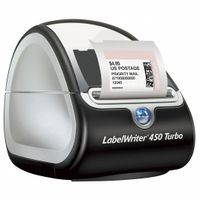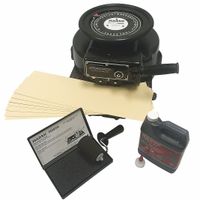Call +(254) 703 030 000 / 751 483 999 / 721 704 777
- Home
- Packaging Shipping
- Package Labels Shipping Equipment
.....Read More
Frequently Asked Questions
What information should be included on a shipping label?
A shipping label should include the following information:
1. **Sender's Information**:
- Name
- Address
- Contact number
2. **Recipient's Information**:
- Name
- Address (including street, city, state, and ZIP/postal code)
- Contact number
3. **Tracking Number**:
- A unique identifier for tracking the package through the shipping process.
4. **Shipping Date**:
- The date the package is shipped.
5. **Package Weight and Dimensions**:
- Accurate weight and size of the package for shipping cost and handling.
6. **Shipping Method**:
- Type of service (e.g., standard, express, overnight).
7. **Barcodes**:
- Machine-readable codes for scanning and tracking.
8. **Carrier Information**:
- Name of the shipping company (e.g., FedEx, UPS, DHL).
9. **Customs Information** (for international shipments):
- Description of contents
- Value of contents
- Harmonized System (HS) code
- Country of origin
10. **Special Instructions**:
- Any handling instructions or delivery notes (e.g., "Fragile", "This Side Up").
11. **Return Address**:
- Address to return the package if delivery fails.
12. **Billing Information**:
- Account number or billing details if applicable.
13. **Reference Numbers**:
- Any additional reference or order numbers for internal tracking.
14. **Hazardous Material Information** (if applicable):
- Details about any hazardous materials contained within the package.
Including all these elements ensures efficient handling, accurate delivery, and compliance with shipping regulations.
How do barcode labels improve inventory management?
Barcode labels significantly enhance inventory management by streamlining operations and increasing accuracy. They automate the tracking process, reducing human error associated with manual data entry. Each barcode is unique to a product, allowing for precise identification and real-time tracking of inventory levels. This ensures that stock levels are accurately maintained, preventing overstocking or stockouts.
Barcodes facilitate faster check-in and check-out processes. Scanning a barcode is quicker than manual entry, speeding up inventory audits and reducing labor costs. This efficiency extends to order fulfillment, where barcodes help ensure the correct items are picked and shipped, improving customer satisfaction.
Inventory data is updated in real-time as barcodes are scanned, providing managers with up-to-date information. This real-time visibility allows for better decision-making regarding purchasing, sales, and inventory replenishment. It also aids in demand forecasting, as historical data can be analyzed to predict future inventory needs.
Barcodes also enhance traceability. In the event of a recall or quality issue, products can be quickly traced back through the supply chain, minimizing potential damage and ensuring compliance with regulatory requirements.
Moreover, barcode systems integrate seamlessly with inventory management software, providing a comprehensive overview of inventory across multiple locations. This integration supports multi-channel operations, ensuring consistency and accuracy in inventory data across all sales platforms.
Overall, barcode labels improve inventory management by enhancing accuracy, efficiency, and visibility, leading to cost savings and improved operational performance.
What are the regulations for hazardous materials shipping labels?
Regulations for hazardous materials shipping labels are primarily governed by the U.S. Department of Transportation (DOT) under the Hazardous Materials Regulations (HMR), and internationally by the International Air Transport Association (IATA) and the International Maritime Organization (IMO).
1. **Label Design and Specifications**: Labels must be durable, weather-resistant, and adhere securely to the package. They should be printed on or affixed to the surface of the package and must remain legible throughout the shipping process.
2. **Size and Color**: Labels must be at least 100 mm x 100 mm (3.9 inches x 3.9 inches) with specific color codes and symbols as per the hazard class. For example, flammable liquids require a red label with a flame symbol.
3. **Language and Symbols**: Labels must include the appropriate hazard symbol, class number, and, if applicable, the UN number. The text should be in English, and additional languages may be required depending on the destination.
4. **Placement**: Labels should be placed on the same surface of the package near the proper shipping name and UN number. They must not be obscured by other labels or markings.
5. **Multiple Hazards**: If a material poses multiple hazards, each applicable label must be displayed. However, precedence of hazard classes may dictate which labels are necessary.
6. **Training and Compliance**: Shippers must ensure that personnel involved in the packaging and labeling of hazardous materials are trained and certified according to DOT and international regulations.
7. **Exceptions and Special Provisions**: Some materials may qualify for exceptions or require additional labeling under special provisions, which are detailed in the HMR and international guidelines.
These regulations ensure the safe and efficient transport of hazardous materials, minimizing risks to people, property, and the environment.
How can I create custom shipping labels with barcodes?
To create custom shipping labels with barcodes, follow these steps:
1. **Choose a Label Design Software**: Use software like Adobe Illustrator, Microsoft Word, or specialized label design software such as BarTender or NiceLabel.
2. **Select a Label Template**: Choose a template that matches your label size. Most software offers standard label sizes, or you can create a custom size.
3. **Design the Label**:
- **Add Text**: Include necessary shipping information such as sender and recipient addresses.
- **Insert Barcode**: Use the software’s barcode tool to generate a barcode. Choose the appropriate barcode type (e.g., Code 128, QR Code) based on your needs.
- **Add Logos/Graphics**: Incorporate company logos or other graphics to personalize the label.
4. **Generate Barcodes**:
- Input the data to be encoded (e.g., tracking number).
- Customize barcode size and format as needed.
- Ensure the barcode is scannable by testing with a barcode scanner.
5. **Print the Labels**:
- Use a high-quality printer, preferably a thermal label printer for durability.
- Select the correct label paper compatible with your printer.
6. **Test the Labels**:
- Verify that all information is correct and the barcode is scannable.
- Make adjustments if necessary.
7. **Automate the Process** (Optional):
- Use shipping software like ShipStation or EasyPost to automate label creation and integrate with e-commerce platforms.
- Set up templates and rules for automatic label generation.
8. **Save and Reuse Templates**: Save your design for future use to maintain consistency and save time.
By following these steps, you can efficiently create custom shipping labels with barcodes tailored to your business needs.
What is the difference between a shipping label and a shipping tag?
A shipping label and a shipping tag serve distinct purposes in the logistics and shipping process, though they are often used interchangeably.
A shipping label is a piece of paper or sticker affixed to a package that contains crucial information for the delivery process. This includes the sender's and recipient's addresses, a barcode for tracking, the shipping method, and any special handling instructions. Shipping labels are generated by the carrier or shipping service provider and are essential for ensuring that a package is delivered accurately and efficiently. They are typically printed using a label printer and are designed to be scanned by automated systems to streamline the sorting and delivery process.
On the other hand, a shipping tag is a more traditional form of identification, often used in conjunction with or as a backup to a shipping label. Shipping tags are usually made of durable materials like cardboard or plastic and are attached to the package with a string or wire. They may contain similar information to a shipping label, such as the sender's and recipient's details, but are often used for additional notes or instructions that may not fit on a label. Shipping tags are particularly useful for items that are irregularly shaped or for situations where a label might not adhere properly.
In summary, while both shipping labels and shipping tags are used to convey information about a package, shipping labels are primarily used for automated processing and tracking, whereas shipping tags provide supplementary or backup information and are often used in more manual or traditional shipping environments.
How do I ensure my shipping labels are compliant with international shipping standards?
To ensure your shipping labels are compliant with international shipping standards, follow these steps:
1. **Research Destination Requirements**: Each country may have specific labeling requirements. Check the destination country's customs website or consult with your shipping carrier for guidelines.
2. **Include Essential Information**: Ensure the label includes the recipient's full name, address, postal code, and country. Include the sender's details as well.
3. **Use the Correct Language**: Labels should be in English and, if required, in the destination country's official language.
4. **Standardized Format**: Follow the Universal Postal Union (UPU) standards for label size and format. Typically, labels should be at least 4x6 inches.
5. **Barcodes and Tracking**: Include a scannable barcode for tracking. Ensure it meets international standards like GS1.
6. **Customs Declaration**: Attach a customs declaration form (e.g., CN22 or CN23) detailing the contents, value, and purpose of the shipment.
7. **Harmonized System (HS) Codes**: Use accurate HS codes for the items being shipped to facilitate customs clearance.
8. **Clear and Legible Printing**: Use high-quality printing to ensure all information is clear and legible. Avoid smudges or fading.
9. **Label Placement**: Place the label on the largest surface of the package, avoiding seams or edges.
10. **Carrier Guidelines**: Follow specific guidelines from your shipping carrier (e.g., DHL, FedEx, UPS) as they may have additional requirements.
11. **Regulatory Compliance**: Ensure compliance with international regulations such as the International Air Transport Association (IATA) for air shipments.
12. **Test and Verify**: Before shipping, test the label with your carrier’s system to ensure it scans correctly and meets all requirements.
By adhering to these guidelines, you can ensure your shipping labels are compliant with international standards, reducing the risk of delays or returns.
What equipment is needed to print shipping labels with barcodes?
To print shipping labels with barcodes, you need the following equipment:
1. **Computer or Mobile Device**: A computer or a mobile device is essential for accessing shipping software or platforms where you can create and manage shipping labels.
2. **Shipping Software or Platform**: Use shipping software or an online platform (like ShipStation, Stamps.com, or a carrier's website) to generate shipping labels. These platforms often provide templates and tools to include barcodes.
3. **Label Printer**: A thermal label printer is recommended for printing shipping labels. These printers are efficient, cost-effective, and specifically designed for label printing. Popular models include the Zebra GK420d, DYMO LabelWriter 4XL, and Rollo Label Printer.
4. **Label Rolls or Sheets**: Ensure you have the correct size and type of label rolls or sheets compatible with your printer. Common sizes for shipping labels are 4x6 inches.
5. **Barcode Scanner (Optional)**: A barcode scanner can be useful for verifying printed barcodes and ensuring they are scannable. This is optional but beneficial for quality control.
6. **Internet Connection**: A stable internet connection is necessary for accessing online shipping platforms and downloading label templates.
7. **Printer Software/Drivers**: Install the necessary drivers and software for your label printer to ensure it functions correctly with your computer or device.
8. **Power Supply and Cables**: Ensure you have all the necessary power supplies and cables to connect your printer to your computer or network.
9. **Backup Supplies**: Keep extra label rolls, printer ribbons (if applicable), and other consumables on hand to avoid interruptions.
This setup will enable you to efficiently print shipping labels with barcodes, ensuring smooth shipping operations.
How do I choose the right label material for my shipping needs?
To choose the right label material for your shipping needs, consider the following factors:
1. **Durability**: Assess the shipping environment. For harsh conditions, such as exposure to moisture, chemicals, or extreme temperatures, opt for durable materials like polyester or vinyl. For standard conditions, paper labels may suffice.
2. **Adhesive Type**: Choose the adhesive based on the surface and conditions. Permanent adhesives are ideal for long-lasting applications, while removable adhesives are suitable for temporary needs. For challenging surfaces, consider high-tack adhesives.
3. **Print Method Compatibility**: Ensure the label material is compatible with your printing method. Thermal transfer labels work well with thermal printers, while inkjet or laser printers require specific materials.
4. **Surface Type**: Consider the surface texture and material of the package. Smooth surfaces work well with most labels, but rough or curved surfaces may require flexible materials.
5. **Environmental Considerations**: If sustainability is a priority, look for eco-friendly materials like recycled paper or biodegradable options.
6. **Regulatory Requirements**: Ensure compliance with any industry-specific regulations, such as those for hazardous materials, which may require specific label materials and adhesives.
7. **Cost**: Balance quality with budget constraints. While durable materials may be more expensive, they can prevent costly issues like label failure.
8. **Aesthetic Needs**: If branding is important, choose materials that support high-quality printing and color retention.
9. **Quantity and Size**: Consider the volume and size of labels needed, as some materials may be more cost-effective in bulk.
By evaluating these factors, you can select a label material that meets your shipping requirements effectively.
What are the best practices for labeling packages for shipping?
1. **Clear and Legible Labels**: Use a high-quality printer to ensure labels are clear and easy to read. Avoid handwriting unless absolutely necessary.
2. **Correct Information**: Include the recipient's full name, address, postal code, and contact number. Double-check for accuracy to prevent delivery errors.
3. **Proper Placement**: Place the label on the largest surface of the package. Ensure it is flat and not on a seam or edge to prevent it from being damaged or obscured.
4. **Use of Barcodes**: Incorporate barcodes for tracking purposes. Ensure they are scannable and not covered or distorted.
5. **Weatherproofing**: Use weather-resistant labels or cover them with clear tape to protect against moisture and abrasion.
6. **Include Return Address**: Clearly display the sender’s return address in case the package needs to be returned.
7. **Handling Instructions**: If necessary, include handling instructions like "Fragile," "This Side Up," or "Perishable" to ensure proper handling.
8. **Avoid Over-labeling**: Remove old labels and barcodes from reused boxes to prevent confusion.
9. **Use of Label Pouches**: For international shipments, use label pouches to include customs documentation securely.
10. **Consistent Labeling Format**: Follow a consistent format for all shipments to streamline the process and reduce errors.
11. **Use of Technology**: Utilize shipping software to generate labels that comply with carrier requirements and include all necessary information.
12. **Test Scannability**: Ensure barcodes and QR codes are scannable by testing them before shipping.
13. **Secure Attachment**: Ensure labels are securely attached to prevent them from peeling off during transit.
14. **Compliance with Carrier Guidelines**: Follow specific guidelines provided by carriers regarding label size, placement, and content to avoid delays.
How do I track shipments using barcode labels?
To track shipments using barcode labels, follow these steps:
1. **Generate Barcode Labels**: Use a barcode generator to create unique barcodes for each shipment. These can be QR codes or traditional barcodes like Code 128 or UPC, depending on your system's requirements.
2. **Attach Barcodes to Shipments**: Print the generated barcodes and securely attach them to the packages. Ensure they are visible and not obscured by other labels or packaging materials.
3. **Scan Barcodes**: Use a barcode scanner or a smartphone with a barcode scanning app to scan the barcodes at various points in the shipping process. This can include when the package is picked up, during transit, and upon delivery.
4. **Integrate with Tracking Software**: Use shipment tracking software that integrates with your barcode system. This software will log each scan and update the shipment's status in real-time, providing visibility into its location and estimated delivery time.
5. **Monitor Shipments**: Access the tracking software to monitor the status of shipments. You can view detailed information such as the current location, transit history, and any delays or issues.
6. **Notify Customers**: Use the tracking information to keep customers informed. Many systems allow you to send automatic updates via email or SMS, providing customers with real-time tracking information.
7. **Analyze Data**: Use the collected data for analysis. This can help identify bottlenecks, improve delivery times, and enhance overall logistics efficiency.
8. **Troubleshoot Issues**: If a shipment is delayed or lost, use the tracking data to identify where it was last scanned and take appropriate action to resolve the issue.
By following these steps, you can effectively track shipments using barcode labels, ensuring efficient and transparent logistics operations.





